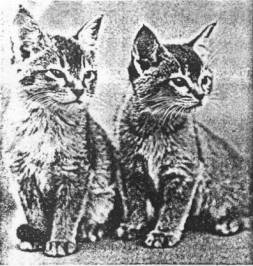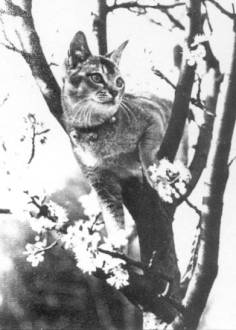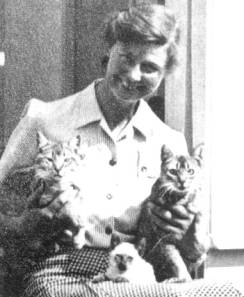Somalis
History of
the Somali
Beginnings
Early articles on the breed
The
Somali: CFA's Newest Championship Breed
The Search Progresses
My
Five Years as a Somali Breeder
Characteristics
What is a Somali like?
Genetics
Where did the Somali originate?
Colors in
which the Somali is available
Health of
the Somali
Color
Study What should the proper color for a fawn
Somali look like? Participate in the discussion!
Other Sites
Cat Fanciers Assoc.
The
Search Progresses
Two ruddy grandchildren of Purrkins:
Monty and Anna. Sired by
Roverdale Rainier out of Brunswycke Chere. Photo courtesy of Janet Robertson The September / October issue of Cat World had barely been delivered by the mailman before readers wrote to give me significant new information on the British bloodlines behind the Somali. In the article, I had cited a pedigree study of the more than 200 Somalis currently registered in North America which traces them all back to a single British import, Raby Chuffa of Selene. However, the study had been unable to complete three generations of English pedigree behind Chuffa. Of special interest were the two Roverdale cats, Tara and her dam, Purrkins. It appeared that Roverdale Purrkins might be a foundation registration, thus opening the possibility that the longhair gene was in her background. Shortly after publication of the Cat World article, I received a letter from Mrs. Janet C. Robertson, who owned the Roverdale cattery and now lives in California. “I was quite astonished to see the Roverdale name in print after all these years,” Mrs. Robertson said. In further correspondence and a phone call, she supplied more details. The story of Roverdale Purrkins turned out to be not only genetically interesting but dramatic and moving. “Purrkins’ grandmother,” she told me, “was brought to England by a sailor during World War II. She had some kittens – I do not know who the sire was. One of the kittens, a female, was given to a friend of mine and the friend gave the kitten to me. This was around 1942. “I had always admired Abyssinians. I had seen them at the Crystal Palace show long ago when I was a little girl. I remember two beautiful Abyssinians with their cages simply covered in ribbons. This must have been two or three years before the Crystal Palace burned down. So I recognized this kitten as an Abyssinian. I named her Mrs. Mew. “I lived in a covered wagon in a field near the Kingston-on-Thomas bypass. London was being blitzed at the time. I was in the Fire Service and stationed in the docks area. My friend looked after my kitten when I was on duty. Incendiary bombs often fell near the wagon, and the field was simply covered with shrapnel. “When the blitz ended, I joined the Mechanized Transport Corps and drove a truck for a factory. “In due time, Mrs. Mews produced kittens. I do not know who the tom was, but one of the kittens was black. The other kitten, Purrkins, looked so much like her Abyssinian mother that I kept her. Mrs. Mew died in 1944. “After the war ended, in 1945, I moved out near Dorking where I started my cattery under the name of Roverdale, and I registered Purrkins. I located an Abyssinian male in Chatham and sent Purrkins to him. Tara was the result of that mating. Unfortunately, I cannot recall the name of the cat or his owners.” Tara was later mated with Lady Barnard’s Raby Ashanto to produce Raby Tosca, the dam of Raby Chuffa. Another of Purrkins’ kittens, Roverdale Rainier, became Mrs. Robertson’s stud. He sired the first red Abyssinians that Mrs. Robertson had ever seen. The reds’ dam was Brunswycke Chere, a ruddy female bought from Mrs. V. Major. Mrs. Roberson registered the reds as Roverdale Tawny and Roverdale Martin. But she became discouraged by judges’ attitudes towards them, and showed them little. Neither Martin nor Tawny ever produced kittens so this early red line died out. The Roverdale cats “won quite a number of cards” in the British show rings, Mrs. Robertson said. She retired from breeding and showing in 1950. Purrkins died in 1956. In 1959 Mrs. Robertson moved to the United States where she lives quietly in Magalia, California. The significant information supplied by Mrs. Robertson is that Purrkins was a foundation registration and that a littermate of Purrkins was black, showing that Mrs. Mew herself was a hybrid. Furthermore, Purrkins’ sire is unknown. It’s obvious that there was ample opportunity here for a longhair gene to creep in. Since the Abyssinian’s agouti color and coat length are both dominant genes, a cat may look like an Aby (thus be eligible for foundation registration) but may carry genes for non-Aby colors and coat length. Another letter from a Cat World reader supplied the remaining information still missing from the pedigree of Raby Chuffa. Upon reading my article, Mrs. Tommy Meadow of the USAF Cattery, well-known for its Abys, went straight to her file, copied out sketch pedigrees on Roverdale Tara and Croham Tchips and mailed them to me.
Her Tara pedigree, though incomplete (she knew nothing about Purrkins’ ancestry), solves the mystery of the registered Abyssinian male to whom Mrs. Robertson bred Purrkins after the war. It was Croham Rasambu. The latter’s pedigree shows yet another unregistered cat who may also have sent non-Aby genes into the Roverdale line and on to Raby Chuffa. Roverdale Tara’s pedigree now looks like this: .
.
.
.
Tim The Harvester .
.
.
Ras Aylu .
.
.
|
Woodrooffe Aura .
.
Woodrooffe Ras Hailu .
.
|
|
Tim The Harvester .
.
|
Cotena .
.
|
.
Sandow Stella .
Croham Rasambu .
|
|
.
Pharaoh .
|
|
Standish Sinia Beyani .
|
|
|
Southampton Ras Babette .
|
Pussner Princess Barna .
|
.
|
Standish Sinia Beyani .
|
.
Raby Debra .
|
.
.
Raby Zulia
Roverdale Tara .
|
.
|
.
|
.
|
Unknown Sire
.
|
|
.
|
|
.
|
|
.
Roverdale Purrkins .
.
|
.
.
|
Unknown Sire
.
.
|
| .
.
Mrs Mew
.
.
.
|
.
.
.
Unknown Dam
Hopefully, some kind British reader might provide me with sketch pedigrees on Standish Sinia Beyani, Ras Aylu, Cotena and, above all, on Raby Debra’s unregistered dam. Mrs. Meadow was not able to complete Croham Tchips’ pedigree either but, as it is, it does take the Aby/Somali lineage back into the 1930s. It also supplies the interesting information that Brooke’s Self Red (a cat known in Britain as Ras Brouck) is in the immediate background. Brooke used this much-discussed cat with his ruddy Abys to improve their color, and some fanciers think he is the origin of the red gene in the Aby. The Ras line also shows at the top of Rasambu’s pedigree. The extraordinary persistence of recessive genes over a long period of time can be shown by the red gene in the Aby / Somali ancestry. Whatever the truth about Ras Brouck’s color, we do know that, in the 1940s, a son of Purrkins and Rasambu sired red kittens. Three generations later, in the 1950s, a descendant of both Rasambu and Tchips, namely Raby Chuffa, sired one of the first reds seen in the U.S. Several generations after that, in the 1960s and 1970s, some Somali lines were throwing reds. For instance, a ruddy Somali named Lynn-Lee’s Catfish, born in 1974, sired red kittens. They are the first known reds to be seen in that line between Catfish and Chuffa himself – a total of 10 generations.
Raby Chuffa is probably not the only Aby who handed down a red gene to Somalis registered today. (According to Mrs. Meadow, Ras Brouck is behind most Abys in the U.S.) My point is simply that the recessive longhair gene, like the recessive red gene, could have had just as long a history – disappearing for several generations at a time but still being faithfully handed down. There are only 8 generations between Roverdale Purrkins and her first longhair descendant to be noted by history – May Ling Tutseita of Dunedin, a Somali who was used in Canada in the 1960’s. The story of Roverdale Purrkins shows that foundation registrations are undoubtedly a major source of “surprise” recessives in the lines of purebred cats. Many foundation registrations were done in the Abyssinian breed, not only in England but in the United States where the practice was still current in the 1950s. This being so, isn’t it possible that foundation registrations outside of the Raby Chuffa lineage could have resulted in Somalis? And isn’t it possible that behind-doors hybridizations and just plain moonlight romances could also have leaked longhair genes into the Somali ancestry? Yes, all these things are very possible. One should not have blind faith in a pedigree or even a few pedigrees. So far, Somali researchers have found the behind-doors hybridizations and moonlight romances impossible to document, though some fanciers still say that Aby/longhair hybridization was done in the U.S. Besides, the researchers always find themselves coming back to the curious fact that all their pedigrees trace back to Chuffa. Random hybridizations, moonlit or otherwise, would also produce a random pattern, thus opening the possibility of a Somali with a pedigree lacking Chuffa’s name. Yet the pedigrees of the over 200 Somalis currently registered with CFA stand like a monolith. For a neat pattern like this to result from behind-doors hybridization would require a conspiracy among the hybridizers of over 20 years’ duration – and breeders who hybridize behind doors don’t ordinarily tell a lot of other people about it. Somali researchers keep looking for that first Somali pedigree that will shatter the pattern. Was Roverdale Purrkins the sole genetrix of the Somali? Or were there others in both countries? More research remains to be done, and new information may still come to light. Mrs. Robertson says she saw no longhairs among her Abys, but she also says she did no line breeding, so any longhair gene that might have been present in her line would not have been exposed at that time. Only later, in the U.S., with the proliferation of Abys, and under the pressure both of inbreeding and of outcrossing of LH-carrying Aby lines with other LH-carrying Aby lines, did Somalis start to show up. As yet, we have no information on the appearance of any Somalis in England. I would appreciate hearing form Aby breeders there who have any knowledge if the early pedigrees, or appearance of a long-haired kitten in an Aby litter, as well as from fanciers in other countries who might have experienced longhaired kittens occurring from imported Abys. The above article first appeared in the January /
February 1978 issue of Cat World Magazine, and is reprinted here by permission
of the author. v |


